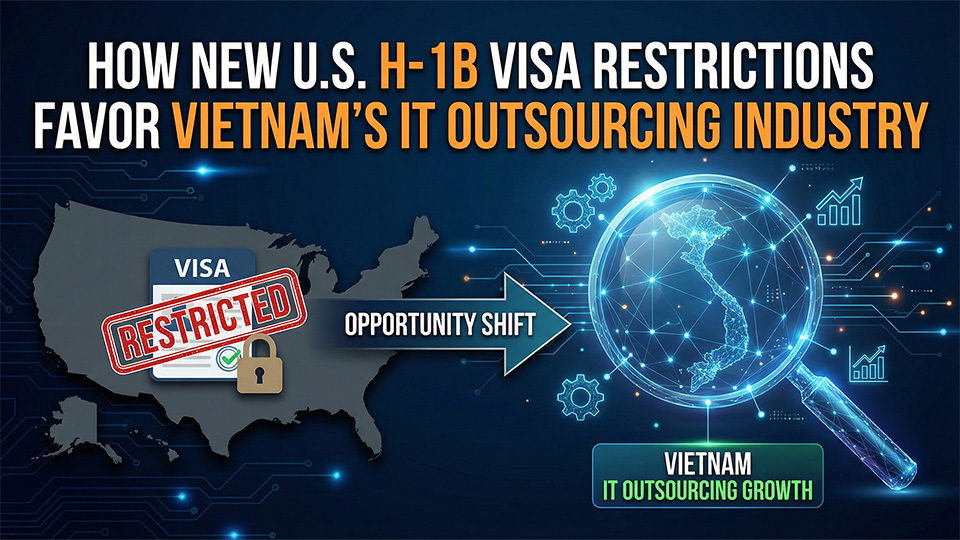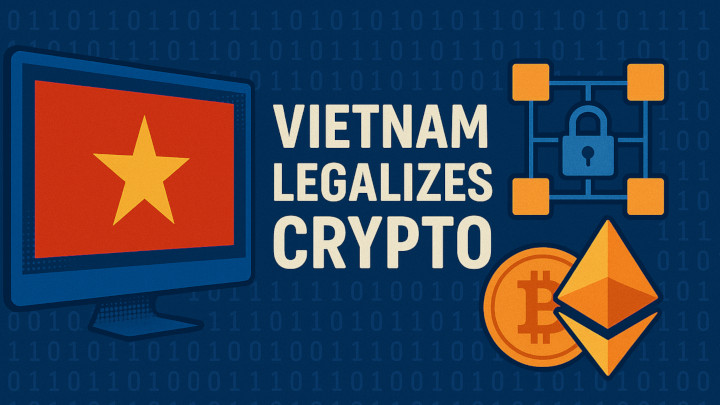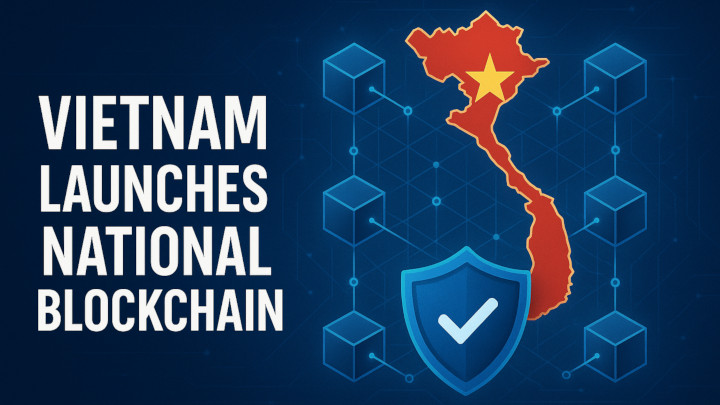July 29, 2025
Vietnam vs India vs Philippines: The 2025 IT Outsourcing Destination Comparison
The global economic landscape in 2025 is characterized by significant shifts, compelling businesses worldwide to re-evaluate their operational strategies.
Countries are increasingly facing the impact of tariffs, leading to a pressing need for cost reduction across industries.
Simultaneously, the rapid evolution of Artificial Intelligence (AI) is fundamentally redefining the IT sector, creating both new demands for developers and innovative tools that enhance productivity and communication.
This confluence of economic pressure and technological advancement has intensified the search for optimal IT outsourcing destinations.
The ability of AI to empower non-native English speakers to achieve communication standards comparable to Western counterparts further broadens the talent pool, making locations previously overlooked due to language barriers now highly competitive.
In this report, Dirox delves into a comprehensive comparison of Vietnam, India, and the Philippines, analyzing their strengths and weaknesses across key criteria to identify the most compelling IT outsourcing choice for the coming years.
The Global Economic and Technological Landscape of 2025
The economic environment in 2025 continues to be shaped by protectionist trade policies, with various nations, including those in Asia, facing elevated tariffs for market access.
While initial concerns about these policies have somewhat stabilized, economists suggest that such tariffs will inevitably dampen global growth and increase consumer prices.
Companies are thus under immense pressure to identify efficiencies and reduce operational expenditures to maintain competitiveness and profitability. This imperative to cut costs extends directly to IT operations, driving a renewed focus on strategic outsourcing.
The talent shortage in AI programming
Concurrently, the IT sector is undergoing a profound transformation driven by AI.
The global AI developer shortage has reached critical levels, with 4.2 million AI positions unfilled worldwide and only 320,000 qualified developers available.
This talent gap costs companies an average of $2.8 million annually in delayed AI initiatives.
Industries such as FinTech (94% reporting critical gaps), HealthTech (89% struggling), and E-commerce (91% facing bottlenecks) are particularly affected.
The demand for AI talent is explosive, with job postings increasing by 85% year-over-year, and the average time to fill AI positions reaching 142 days. This scarcity compels companies to aggressively compete for limited talent or explore alternative solutions, such as offshore development teams.
A widespread adoption of AI coding with astounding results
Beyond the talent shortage, AI is fundamentally changing how software development is conducted.
By 2025, AI adoption in software engineering has reached near saturation, with 97.5% of companies integrating AI technologies into their processes.
Key use cases include code generation (72.2%), documentation generation (67.1%), and code review and optimization (67.1%).
This widespread adoption has led to tangible productivity boosts, with 82% of respondents reporting at least a 20% increase, and 25% seeing over 50% improvement.
The primary objectives for this deep AI adoption are enhancing productivity and reducing operational costs (84% of respondents), and increasing development speed (77.8%).
Unlocking new pools of talents
Crucially, AI is also democratizing access to high-quality communication, a factor historically critical for outsourcing success.
Non-native English speakers, who often face barriers in academic and professional communication, can now leverage AI and translation tools to significantly improve their writing style, correct grammatical errors, and restructure sentences to meet Western standards.
Programs like Grammarly, Paperpal, and ChatGPT are proving invaluable for enhancing clarity and coherence in scientific and technical writing.
This technological advancement effectively mitigates traditional language barriers, allowing businesses to consider a broader range of talent pools based on technical skill and cost-effectiveness, rather than solely on native-level English fluency.
This development levels the playing field, making countries with strong technical talent but developing English proficiency more viable and attractive for IT outsourcing.
Cost Comparison Matrices
When evaluating IT outsourcing destinations, cost-effectiveness remains a primary driver.
This section provides a detailed comparison of developer salaries, cost of living, and key operational expenses across Vietnam, India, and the Philippines for 2025.
Developer Salaries
Vietnam consistently offers highly competitive rates. A software developer in Vietnam earns approximately $15–25 per hour, or hourly development rates ranging from $20 to $40. For developers with 5–9 years of experience, the average annual salary is around $28,400. Entry-level salaries start at approximately $480 per month, demonstrating a substantial cost advantage compared to Western markets.
India, while renowned for its affordability, presents slightly higher developer rates. Hourly rates typically range from $5 to $25, or between $25 and $50 according to other sources. The average annual salary for a software developer in India was approximately $10,700 in 2023, with those having 5–9 years of experience earning around $17,400 per year. Overall, the average salary for outsourcing roles in India is reported to be around ₹19.6 lakhs per annum, which translates to approximately $23,600, with top earners reaching up to ₹50 lakhs ($60,000).
The Philippines also offers competitive rates, with hourly ranges from $6 to $20, or $25 to $50. Experienced developers in the Philippines can earn between $15,000 and $25,000 annually, with some estimates for experienced developers reaching $20,000 to $30,000 per year, particularly for those skilled in emerging technologies like AI or blockchain. Senior developers can command monthly salaries ranging from ₱90,000 to ₱160,000, equivalent to approximately $1,550 to $2,750.
Cost of Living
Vietnam's average cost of living is about 28.7 as of April 2025, with Ho Chi Minh City at 30.5 and Hanoi at 29.2. The national average monthly income reached about VND 8.3 million (approximately $317) by mid-2025. This indicates that while Vietnam is slightly more expensive than India in terms of general living expenses, it remains highly affordable compared to Western countries.
The cost of living directly impacts labor costs and the overall attractiveness of a location for talent. As of April 2025, India generally has the lowest cost of living among the three, with an average Cost of Living (COL) Index of approximately 21.2. Major cities like Mumbai have a COL Index of 25.4, while Delhi is at 22.9. A single individual can live comfortably in India with an income of ₹40,000 to ₹50,000 per month (approximately $480-$600), including rent and other expenses.
The Philippines has the highest cost of living among the three, with an average COL Index of about 31 as of April 2025. Another source indicates a COL Index of 35.9. For entry-level roles, the average annual salary is projected to rise to approximately $8,000 to $10,000 by 2025. While still significantly more affordable than Western markets, the Philippines' higher cost of living compared to India and Vietnam can translate to higher overall labor costs for businesses.
Operational Costs: Office Space, Electricity, and Data Centers
Beyond salaries and living expenses, operational costs such as office rent, electricity, and data center services play a crucial role in overall outsourcing expenditures.
Office Space
India generally offers the most affordable office rents. In Q2 2025, Mumbai's prime office rents were around ₹168 per square foot per month (approximately $2.02/sqft or $21.78/sqm), Delhi-NCR at ₹110 per square foot per month (approximately $1.32/sqft or $14.2/sqm), and Bengaluru at ₹117 per square foot per month (approximately $1.41/sqft or $15.18/sqm). Average rental values across India are forecast to reach ₹100-110 per square foot per month (approximately $1.20-$1.32/sqft or $12.9-$14.2/sqm).
In the Philippines, the average headline rent for Prime and Grade 'A' developments in Metro Manila was recorded at PHP 987 per square meter per month (approximately $17.02/sqm) by the end of Q1 2025. Grade A office spaces in Metro Manila dropped to an average of ₱970 per square meter per month ($16.4/sqm) in 2024. Manila's prime office rent was also noted as the fourth most affordable in the Asia-Pacific region at $31.58 per square foot a year (approximately $2.63/sqft or $28.3/sqm/month) in Q1 2025.
Vietnam's office rents, while higher than India's, are competitive. In Ho Chi Minh City, the average office rent has risen to VND 833,000 per square meter per month (approximately $33.32/sqm). In Hanoi, net effective rent in the CBD reached $32.6 per square meter per month. Despite these figures, the Hanoi office market is expected to become a "tenants' market" by the end of 2025 or 2026 due to abundant new supply, offering more attractive incentives. This indicates a potential for more favorable leasing terms in the near future.
Electricity Costs
For businesses, electricity costs are a critical factor.
Vietnam offers highly competitive commercial electricity rates, averaging around $0.084 per kWh in May 2025, with rates as low as $0.077 per kWh.
India's business electricity rates range from $0.077 to $0.126 per kWh.
The Philippines has significantly higher rates, ranging from $0.151 to $0.203 per kWh. This makes Vietnam and India considerably more cost-effective for power consumption than the Philippines.
Data Center Costs
Data center operational costs, particularly power, are crucial for IT-intensive operations.
Vietnam stands out with exceptionally low data center power costs, with Ho Chi Minh City averaging $18.9 per kilowatt per month. The average development cost for data centers, including construction and land, is approximately $7.1 million per megawatt, significantly below the regional average.
The Philippines' Metro Manila, in contrast, has a much higher data center power cost of $98 per kilowatt per month.
India's data center industry is booming, with installed IT power forecast to leap from 1.26 GW in April 2025 to over 4.5 GW by 2030, driven by AI workloads. While specific per kW per month costs are not provided for India in the available data, the sheer scale of investment and demand indicates a robust but potentially more competitive market for pricing.
Skill Set Availability Analysis
The availability and quality of a skilled IT workforce are paramount for successful outsourcing. This section examines the talent pools, specialized skills in emerging technologies, and the effectiveness of technical education and industry-academia collaboration in each country.
Talent Pool Size and Quality
India boasts the largest and most mature software development outsourcing market globally, with over 5 million IT professionals. Its AI talent pool alone crossed 400,000 in 2025. The sheer volume of talent provides a vast resource for various IT needs.
The Philippines has a rapidly expanding talent pool, estimated at around 400,000 IT professionals in 2023 , with the broader IT-BPM industry reaching 1.82 million employees in 2024, projected to hit 1.9 million by the end of 2025. The country produces approximately 350,000 STEM graduates annually, contributing to this growth.
Vietnam, while possessing a smaller overall talent pool compared to India, has a robust and rapidly growing IT workforce of approximately 560,000 professionals. This pool is bolstered by a significant influx of new talent, with about 55,000-60,000 students joining computer science and IT-related majors every year.
Specialized Skills in Emerging Technologies
The demand for specialized skills in emerging technologies like AI, Machine Learning (ML), Cloud Computing, and Cybersecurity is surging.
Vietnam is actively cultivating expertise in these areas. Its digital economy is projected to reach $43 billion by 2025, with AI being a major contributor, and the AI market is projected to reach $3.4 billion by 2030.
Over 80% of IT professionals in Vietnam are already utilizing AI tools in their daily work, indicating a high rate of adoption and practical application. The government's ambition for 100% cloud adoption in government agencies by 2025 further underscores the country's commitment to cloud expertise.
Vietnam is also making strides in cybersecurity, ranking 25th globally in readiness, with the government mandating that public organizations allocate at least 10% of their IT budget to cybersecurity. This strategic focus and high adoption rate position Vietnam's talent pool as highly future-ready and aligned with the evolving demands of IT outsourcing.
India also faces a high demand for AI and ML talent, with roles like Data Scientists, ML Engineers, AI Developers, and AI Researchers topping hiring charts. Despite a large AI talent pool exceeding 400,000, India grapples with a significant demand-supply gap of 51% in AI professionals. The country's IT sector is experiencing massive growth, with job opportunities expected to jump 15-20% by 2025, driven by AI, blockchain, and cybersecurity.
In the Philippines, in-demand tech jobs for 2025 include software developers, data scientists, and AI specialists. The machine learning market is experiencing significant growth, with projections showing a 35.77% growth rate from 2024 to 2030. Cloud computing skills, particularly in AWS and Azure, are becoming essential, and the cybersecurity landscape is intense, with the Philippines facing an average of 5 billion cyberattacks daily.
Technical Education System and Industry-Academia Collaboration
A strong technical education system and robust industry-academia collaboration are vital for producing job-ready talent.
Vietnam benefits from a strong education pipeline, with more than 50,000 IT graduates entering the workforce each year from leading universities such as Ho Chi Minh City University of Technology and Hanoi University of Science and Technology. Crucially, technical English is mandatory in Vietnamese university IT programs, and international tech certifications are government-subsidized, directly addressing skill gaps and preparing graduates for international collaboration. Furthermore, government policies actively enhance collaboration between government, academia, and industry stakeholders, fostering an ecosystem that aligns educational output with industry needs.
India has premier educational and research institutions, with the Indian Institute of Technology Delhi (IITD) being a top university in Southern Asia. However, India's education system often struggles to translate into employment due to weak industry linkages and poor employment opportunities. A significant portion of surveyed institutions (45%) lack dedicated faculty for international engagement, and 41% have no active international collaborations. High-end equipment in labs often serves as a symbol of prestige rather than national utility, and bureaucratic hurdles limit access for private companies and startups, hindering technology transfer and collaborative growth. This creates a disconnect where despite a large talent pool, practical, industry-relevant skills may be lacking, leading to a "brain drain" as graduates seek opportunities abroad.
The Philippines has a notable number of universities ranked in the Times Higher Education Impact Rankings 2025, with 121 institutions listed, the highest among ASEAN countries. The government actively supports the BPO sector through workforce development programs. However, the country is still in an "emergent stage" for industry-academe linkage activities, particularly in collaborative R&D. While the legal environment is supportive, the scale of science and technology manpower-building and R&D expenditures falls short of its potential. Nevertheless, fields like Mathematics and Computer Science show "moderate to high levels of engagement" with industry, especially in curriculum development and on-the-job training.
Cultural Fit Assessment
Cultural compatibility and effective communication are vital for seamless IT outsourcing partnerships, influencing project success and team cohesion.
English Proficiency and Communication Styles
English proficiency is a key determinant of communication effectiveness in outsourcing.
The Philippines holds a strong advantage in this regard, ranking 20th globally in English proficiency (EF EPI 2023). Its workforce is known for a "higher level of English proficiency," a neutral accent, and familiarity with Western culture, which significantly eases communication and minimizes the risk of miscommunication, especially for customer-facing roles.
India ranks 60th globally in English proficiency (EF EPI 2023). While a large portion of the Indian population is fluent in English, the presence of numerous regional dialects and varying accents can sometimes present communication challenges for Western clients.
Vietnam's English proficiency is rapidly improving, though it currently ranks 63rd globally (EF EPI 2024) and 8th in Asia. Technical English is mandatory in Vietnamese university IT programs, ensuring a foundational understanding for technical communication. However, Vietnam still faces hurdles with accents that some Western ears might find challenging in real-time conversation, and less experience with direct negotiation compared to more established outsourcing markets.
Despite these traditional differences, the rise of AI-powered communication tools significantly reduces the impact of conventional language barriers.
AI programs like Grammarly and Paperpal can correct grammatical errors and improve writing style, while tools like ChatGPT can restructure sentences, reword text, and suggest appropriate phrases. These capabilities enable non-native English speakers to enhance the clarity, style, and coherence of their written communication, bringing it up to Western standards.
Work Ethic and Cultural Alignment
Beyond language, work ethic and cultural alignment influence collaboration dynamics.
Vietnamese professionals bring distinctive cultural strengths to the table, including a detail-oriented approach to technical specifications, a strong commitment to meeting deadlines and deliverables, and a mathematically rigorous problem-solving methodology.
The Philippines is well-regarded for its strong work ethic and cultural alignment with Western markets, largely due to historical ties that have blended Southeast Asian and Western influences. This cultural resemblance often results in a smoother and more seamless outsourcing experience, particularly for customer-facing roles where familiarity with Western nuances is beneficial.
India has a longer history of outsourcing and a general familiarity with Western business practices. Successful collaboration with Indian teams often relies on clearly defined workflows, robust documentation, and effective project management tools to bridge any cultural or communication nuances.
Risk Factors & Stability – Ensuring Business Continuity
Assessing risk factors and overall stability is crucial for long-term outsourcing partnerships, ensuring business continuity and investment security.
Political Stability and Governance
Political stability is a fundamental consideration for any international business engagement.
Based on the World Bank's Worldwide Governance Indicators for 2023, Vietnam demonstrates a relatively higher degree of political stability. Its Political Stability and Absence of Violence/Terrorism estimate was -0.04 points in 2023, which is an improvement from the previous year and is better than the world average of -0.06 points.
Vietnam has cultivated a reputation for stability and predictability, qualities highly valued by corporations making significant investments. The Communist Party of Vietnam has set ambitious goals, including achieving high-income status by 2045, which drives proactive policies that balance foreign investment with long-term resilience.
India's Political Stability and Absence of Violence/Terrorism estimate was -0.64 points in 2023, placing its percentile rank at 21. India has faced persistent struggles with regulatory complexities and infrastructure bottlenecks, which can deter foreign investment and impact business operations.
The Philippines' Political Stability and Absence of Violence/Terrorism percentile rank for 2023 was 24. Historically, the Philippines has experienced fluctuating rankings in political stability.
Legal Frameworks: Data Protection and Intellectual Property
Robust legal frameworks for data protection and intellectual property (IP) are essential for safeguarding sensitive business information in outsourcing.
Vietnam has made significant strides in this area, with its new data protection law, Decree 13, bringing the country's data governance closer in line with GDPR-style global benchmarks. This alignment is a considerable advantage for international businesses concerned with stringent data privacy regulations. Furthermore, Vietnam has a clear stance on AI-generated IP: AI cannot be an IP right owner, and the user of the AI is considered the owner, regardless of the degree of work carried out by the AI. This clarity provides certainty for businesses leveraging AI in their development processes.
India's Digital Personal Data Protection Act, 2023 (DPDPA), with draft rules released in early 2025, marks a pivotal shift towards data protection. While it borrows principles from the EU's GDPR, it also diverges in key areas, applying exclusively to digital personal data and relying heavily on consent as the primary legal basis for processing. Cross-border data transfers are permitted unless specifically restricted by the government. Despite these advancements, India remains on the Priority Watch List in the USTR's Special 301 report concerning IP issues, suggesting ongoing challenges in IP enforcement.
In the Philippines, copyright law stipulates that the author must be a natural person, meaning that copyright in partially AI-generated works protects only the human-created parts. However, data rights and privacy are not explicitly prioritized, with resources primarily allocated to cyber defense capacity building.
Cybersecurity Landscape and Readiness
Cybersecurity is a critical component of risk assessment in IT outsourcing, directly impacting data integrity and business trust.
Vietnam demonstrates a commendable level of preparedness, ranking 25th globally in cybersecurity readiness. The Vietnamese government has mandated that public organizations allocate at least 10% of their IT budget to cybersecurity, reflecting a strong national commitment to digital security.
India, despite increased awareness of cyber threats, lags significantly in cybersecurity readiness maturity. According to Cisco's 2025 Cybersecurity Readiness Index, only 7% of organizations in India have reached a 'Mature' level of cybersecurity readiness, a marginal improvement from 4% in 2024. This indicates a persistent gap between confidence and actual capability. Furthermore, 45% of Indian organizations lack visibility into "shadow AI deployments," and a staggering 92% report a critical shortage of skilled cybersecurity professionals, exacerbating their vulnerability to evolving threats.
The Philippines faces an intense cybersecurity landscape, experiencing an average of 5 billion cyberattacks daily. While the Department of Information and Communications Technology (DICT) received a substantial 49.2% budget increase for cybersecurity in 2025, indicating government recognition of the threat, the high volume of attacks suggests a challenging environment for maintaining digital security.
Infrastructure Reliability: Power, Internet, and Transportation
Reliable infrastructure is foundational for uninterrupted business operations in IT outsourcing.
Vietnam stands out for its robust and proactive infrastructure development. The government has prioritized developing ports, highways, and industrial parks, ensuring efficient movement of goods and services. In terms of internet connectivity, Vietnam offers a low monthly internet cost of approximately $10.83 with a median speed of 71.86 Mbps. Overall, Vietnam is recognized as a "regional leader in infrastructure development". This comprehensive approach to infrastructure development directly translates into higher operational efficiency and reduced logistical complexities for businesses.
India, despite its ambitious initiatives like the Digital India program, continues to face persistent infrastructure challenges. Congested roads, unreliable power supply in many regions, and underdeveloped logistics networks inflate costs and delay timelines for businesses. A significant portion of its population, 41%, remains offline, indicating a substantial digital divide. The median fixed internet speed in India is 63.55 Mbps. While major broadband providers offer speeds up to 1 Gbps, the overall reliability can vary, and challenges like power pass-through markups for data centers exist.
The Philippines is actively investing in its digital sector, with ongoing efforts to improve data centers and broadband infrastructure. However, 26% of its population remains offline, and consumer affordability of data plans is a top concern. The average fixed broadband speed is 93.90 Mbps. Major infrastructure projects, such as the North-South Commuter Railway and Metro Manila subway, are underway to enhance transportation networks. Despite these efforts, the Philippines still has significant opportunities to bridge its digital divide and improve overall infrastructure reliability.
Vietnam's Ascendancy: The Preferred Choice for 2025
Synthesizing the comprehensive analysis across cost, talent, cultural fit, and risk factors, Vietnam emerges as the optimal IT outsourcing destination for 2025.
Its unique combination of rapidly developing specialized talent, exceptionally low operational costs, a highly stable political environment, and proactive government support positions it as a strategic pivot for businesses seeking long-term value, innovation, and reduced risk in the evolving global landscape.
Synthesizing Vietnam's Strategic Advantages
Vietnam presents a compelling value proposition that extends far beyond mere cost savings. In terms of cost-effectiveness, Vietnam offers a significant advantage, with developer rates reported to be 15-30% less than their Indian counterparts and 30-40% lower than India or China overall. This competitive pricing is further amplified by some of the lowest commercial electricity rates ($0.077-$0.084/kWh) and data center power costs ($18.9/kW/month) among the compared nations. While office rents may be slightly higher than in India, the market is becoming more tenant-favorable, offering potential for attractive incentives.
Regarding talent and skill set, Vietnam boasts a rapidly growing and youthful IT workforce of 560,000 professionals, with 55,000-60,000 new IT graduates annually. This continuous influx of young, adaptable talent is strategically focused on emerging technologies. Vietnam demonstrates a strong emphasis on AI, Machine Learning, Cloud Computing, and Cybersecurity, with a high daily adoption rate of AI tools by IT professionals. The nation excels in agile-based development models and custom software development, particularly in industries like fintech and e-commerce. This focus on future-ready skills ensures that Vietnam's talent pool is not just growing in quantity but also in quality and relevance to modern IT demands.
In terms of cultural fit and communication, while the Philippines traditionally leads in English proficiency, Vietnam's English skills are rapidly improving, with technical English being mandatory in universities. The increasing sophistication of AI tools further bridges any remaining communication gaps, enabling non-native speakers to achieve Western communication standards for technical roles. Vietnamese professionals are known for their detail-oriented approach and strong commitment to meeting deadlines, which are invaluable attributes for successful project delivery.
Finally, Vietnam offers a robust and predictable environment in terms of risk and stability. It exhibits higher political stability compared to both India and the Philippines, as indicated by World Bank governance indicators. The government's proactive support for digital transformation and the IT sector, including new corporate income tax exemptions for SMEs, creates a highly enabling business environment. Furthermore, Vietnam's robust infrastructure development in power, internet, and transportation, coupled with new data protection laws aligning with GDPR-style benchmarks, significantly reduces operational risks and enhances data security for international partners. Its ranking as 25th globally in cybersecurity readiness further underscores its commitment to a secure digital ecosystem.
Success Stories and Future Outlook
Vietnam's IT outsourcing industry is on an undeniable upward trajectory.
Its revenue is projected to nearly double from US0.7billion in 2024 to US1.28 billion by 2028, maintaining a robust compound annual growth rate (CAGR) of 17%. The tech sector's growing economic significance is underscored by its projection to contribute nearly 30% to Vietnam's GDP by 2030.
The country has demonstrated significant success in various industry-specific customizations. In fintech, an impressive 95% of local banks are actively adopting new technologies such as mobile payments, digital identity verification, and AI-driven risk assessments, making Vietnam a prime destination for fintech development outsourcing.
The manufacturing sector is integrating IoT technologies into smart factory solutions, and the e-commerce sector is evolving towards Online-Merge-Offline (OMO) retail experiences powered by AI, big data, and cloud analytics.
These examples illustrate Vietnam's capacity for specialized, high-impact solutions and its commitment to digital transformation across diverse industries. The government's Country Digital Acceleration (CDA) program and new corporate income tax exemptions for newly established SMEs, including foreign-owned IT firms, further reduce barriers to entry and ease initial operational costs, solidifying Vietnam's reputation as a burgeoning tech hub.
Conclusion: Strategic Imperatives for IT Outsourcing in the New Era
The landscape of IT outsourcing in 2025 is defined by a critical need for cost optimization amidst global economic pressures and a burgeoning demand for specialized AI-driven talent. In this dynamic environment, Vietnam emerges as the most strategically advantageous IT outsourcing destination.
Our analysis demonstrates that Vietnam offers an unparalleled blend of attributes: highly competitive developer salaries and operational costs, a rapidly growing and future-ready talent pool specializing in critical emerging technologies like AI and Cloud, a rapidly improving communication environment bolstered by AI tools, and a stable political and legal framework with robust infrastructure.
While India provides a vast and mature market, and the Philippines excels in general English proficiency and cultural alignment for BPO, Vietnam's focused development, proactive governance, and emphasis on long-term value creation position it as the optimal choice for businesses seeking agile innovation, reduced risk, and sustainable growth in their IT operations.
For organizations navigating the complexities of 2025, a strategic pivot towards Vietnam for IT outsourcing is not merely a cost-cutting measure but a forward-looking investment in a high-quality, resilient, and technologically advanced partnership.
By leveraging Vietnam's unique strengths, businesses can secure a competitive edge, ensuring their IT initiatives are not only cost-effective but also aligned with the demands of the AI-driven future.
Contact Dirox today to learn more!





























.svg)













